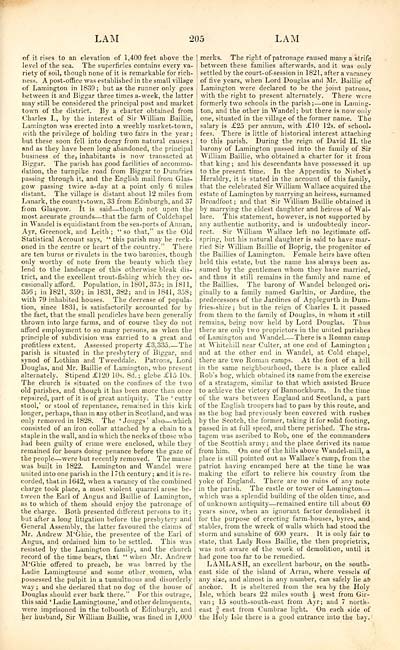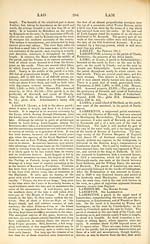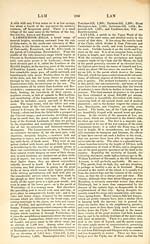Topographical, statistical, and historical gazetteer of Scotland > Volume 2
(217) Page 205
Download files
Complete book:
Individual page:
Thumbnail gallery: Grid view | List view

LAM
205
LAM
of it rises to an elevation of 1,400 feet above the
level of the sea. The superficies contains every va-
riety of soil, though none of it is remarkable for rich-
ness. A post-office was established in the small village
of Lamington in 1839 ; but as the runner only goes
between it and Biggar three times a-week, the latter
may still be considered the principal post and market
town of the district. By a charter obtained from
Charles I., by the interest of Sir William Baillie,
Lamington was erected into a weekly market-town,
ivith the privilege of holding two fairs in the year ;
but these soon fell into decay from natural causes ;
and as they have been long abandoned, the principal
business of thej inhabitants is now transacted at
Biggar. The parish has good facilities of accommo-
dation, the turnpike road from Biggar to Dumfries
passing through it, and the English mail from Glas-
gow passing twice a-day at a point only 6 miles
distant. The village is distant about 12 miles from
Lanark, the county-town, 33 from Edinburgh, and 37
from Glasgow. It is said — though not upon the
most accurate grounds — that the farm of Coldchapel
in Wandel is equidistant from the sea-ports of Annan,
Ayr, Greenock, and Leith ; " so that," as the Old
Statistical Account says, " this parish may be reck-
oned in the centre or heart of the country." There
are ten burns or rivulets in the two baronies, though
only worthy of note from the beauty which they
lend to the landscape of this otherwise bleak dis-
trict, and the excellent trout-fishing which they oc-
casionally afford. Population, in 1801, 375; in 1811,
356; in 1821, 359; in 1831, 382; and in 1841, 358;
with 79 inhabited houses. The decrease of popula-
tion, since 1831, is satisfactorily accounted for by
the fact, that the small pendicles have been generally
thrown into large farms, and of course they do not
afford employment to so many persons, as when the
principle of subdivision was carried to a great and
profitless extent. Assessed property £3,335 The
parish is situated in the presbytery of Biggar, and
synod of Lothian and Tweeddale. Patrons, Lord
Douglas, and Mr. Baillie of Lamington, who present
alternately. Stipend £120 10s. 8d. ; glebe £15 10s.
The church is situated on the confines of the two
old parishes, and though it has been more than once
repaired, part, of it is of great antiquity. The ' cutty
stool,' or stool of repentance, remained in this kirk
longer, perhaps, than in any other in Scotland, and was
only removed in 1828. The 'Jouggs' also — which
consisted of an iron collar attached by a chain to a
staple in the wall, and in which the necks of those who
had been guilty of crime were enclosed, while they
remained for hours doing penance before the gaze of
the people — were but recently removed. The manse
was built in 1822. Lamington and Wandel were
united into one parish in the 17th century; and it is re-
corded, that in 1642, when a vacancy of the combined
charge took place, a most violent quarrel arose be-
tween the Earl of Angus and Baillie of Lamington,
as to which of them should enjoy the patronage of
the charge. Both presented different persons to it;
but after a long litigation before the presbytery and
General Assembly, the latter favoured the claims of
Mr. Andrew M'Ghie, the presentee of the Earl of
Angus, and ordained him to be settled. This was
resisted by the Lamington family, and the church
record of the time bears, that " when Mr. Andrew
M'Ghie offered to preach, he was barred by the
Ladie Lamiugtoune and some other women, wha
possessed the pulpit in a tumultuous and disorderly
way ; and she declared that no dog of the house of
Douglas should ever bark there." For this outrage, j
this said ' Ladie Lamiugtoune,' and other delinquents,
were imprisoned in the tolbooth of Edinburgh, and
her husband, Sir William Baillie, was fined in 1,000
merks. The right of patronage caused many a strife
between these families afterwards, and it was only
settled by the court-of-session in 1821, after a vacancy
of five years, when Lord Douglas and Mr. Baillie of
Lamington were declared to be the joint patrons,
with the right to present alternately. There were
formerly two schools in the parish ; — one in Laming-
ton, and the other in Wandel; but there is now only
one, situated in the village of the former name. The
salary is £25 per annum, with £10 12s. of school-
fees. There is little of historical interest attaching
to this parish. During the reign of David II. the
barony of Lamington passed into the family of Sir
William Baillie, who obtained a charter for it from
that king; and his descendants have possessed it up
to the present time. In the Appendix to Nisbet's
Heraldry, it is stated in the account of this family,
that the celebrated Sir William Wallace acquired the
estate of Lamington by marrying an heiress, surnamed
Broadfoot; and that Sir William Baillie obtained it
by marrying the eldest daughter and heiress of Wal-
lace. This statement, however, is not supported by
any authentic authority, and is undoubtedly incor-
rect. Sir William Wallace left no legitimate off-
spring, but his natural daughter is said to have mar-
ried Sir William Baillie of Boprig, the progenitor of
the Baillies of Lamington. Female heirs have often
held this estate, but the name has always been as-
sumed by the gentlemen whom they have married,
and thus it still remains in the family and name of
the Baillies. The barony of Wandel belonged ori-
ginally to a family named Garltin, or Jardine, the
predecessors of the Jardines of Applegurth in Dum-
fries-shire; but in the reign of Charles I. it passed
from them to the family of Douglas, in whom it still
remains, being now held by Lord Douglas. Thus
there are only two proprietors in the united parishes
of Lamington and Wandel There is a Roman camp
at Whitehill near Culter, at one e-nd of Lamington ;
and at the other end in Wandel, at Cold chapel,
there are two Roman camps. At the foot of a hill
in the same neighbourhood, there is a place called
Rob's bog, which obtained its name from the exercise
of a stratagem, similar to that which assisted Bruce
to achieve the victory of Bannockburn. In the time
of the wars between England and Scotland, a part
of the English troopers had to pass by this route, and
as the bog had previously been covered with rushes
by the Scotch, the former, taking it for solid footing,
passed in at full speed, and there perished. The stra-
tagem was ascribed to Rob, one of the commanders
of the Scottish army; and the place derived its name
from him. On one of the hills above Wandel-mill, a
place is still pointed out as Wallace's camp, from the
patriot having encamped here at the time he was
making the effort to relieve his country from the
yoke of England. There are no ruins of any note
in the parish. The castle or tower of Lamington —
which was a splendid building of the olden time, and
of unknown antiquity — remained entire till about 60
years since, when an ignorant factor demolished it
for the purpose of erecting farmhouses, byres, and
stables, from the wreck of walls which had stood the
storm and sunshine of 600 years. It is only fair to
state, that Lady Ross Baillie, the then proprietrix,
was not aware of the work of demolition, until it
had gone too far to be remedied.
LAMLASH, an excellent harbour, on the south-
east side of the island of Arran, where vessels of
any size, and almost in any number, can safely lie at>
anchor. It is sheltered from the sea by the Holy
Isle, which bears 22 miles south \ west from Gir-
van; 15 south-south-east from Ayr; and 7 north-
east J east from C umbrae light. On each side of
the Holy Isle there is a good entrance into the bay.
205
LAM
of it rises to an elevation of 1,400 feet above the
level of the sea. The superficies contains every va-
riety of soil, though none of it is remarkable for rich-
ness. A post-office was established in the small village
of Lamington in 1839 ; but as the runner only goes
between it and Biggar three times a-week, the latter
may still be considered the principal post and market
town of the district. By a charter obtained from
Charles I., by the interest of Sir William Baillie,
Lamington was erected into a weekly market-town,
ivith the privilege of holding two fairs in the year ;
but these soon fell into decay from natural causes ;
and as they have been long abandoned, the principal
business of thej inhabitants is now transacted at
Biggar. The parish has good facilities of accommo-
dation, the turnpike road from Biggar to Dumfries
passing through it, and the English mail from Glas-
gow passing twice a-day at a point only 6 miles
distant. The village is distant about 12 miles from
Lanark, the county-town, 33 from Edinburgh, and 37
from Glasgow. It is said — though not upon the
most accurate grounds — that the farm of Coldchapel
in Wandel is equidistant from the sea-ports of Annan,
Ayr, Greenock, and Leith ; " so that," as the Old
Statistical Account says, " this parish may be reck-
oned in the centre or heart of the country." There
are ten burns or rivulets in the two baronies, though
only worthy of note from the beauty which they
lend to the landscape of this otherwise bleak dis-
trict, and the excellent trout-fishing which they oc-
casionally afford. Population, in 1801, 375; in 1811,
356; in 1821, 359; in 1831, 382; and in 1841, 358;
with 79 inhabited houses. The decrease of popula-
tion, since 1831, is satisfactorily accounted for by
the fact, that the small pendicles have been generally
thrown into large farms, and of course they do not
afford employment to so many persons, as when the
principle of subdivision was carried to a great and
profitless extent. Assessed property £3,335 The
parish is situated in the presbytery of Biggar, and
synod of Lothian and Tweeddale. Patrons, Lord
Douglas, and Mr. Baillie of Lamington, who present
alternately. Stipend £120 10s. 8d. ; glebe £15 10s.
The church is situated on the confines of the two
old parishes, and though it has been more than once
repaired, part, of it is of great antiquity. The ' cutty
stool,' or stool of repentance, remained in this kirk
longer, perhaps, than in any other in Scotland, and was
only removed in 1828. The 'Jouggs' also — which
consisted of an iron collar attached by a chain to a
staple in the wall, and in which the necks of those who
had been guilty of crime were enclosed, while they
remained for hours doing penance before the gaze of
the people — were but recently removed. The manse
was built in 1822. Lamington and Wandel were
united into one parish in the 17th century; and it is re-
corded, that in 1642, when a vacancy of the combined
charge took place, a most violent quarrel arose be-
tween the Earl of Angus and Baillie of Lamington,
as to which of them should enjoy the patronage of
the charge. Both presented different persons to it;
but after a long litigation before the presbytery and
General Assembly, the latter favoured the claims of
Mr. Andrew M'Ghie, the presentee of the Earl of
Angus, and ordained him to be settled. This was
resisted by the Lamington family, and the church
record of the time bears, that " when Mr. Andrew
M'Ghie offered to preach, he was barred by the
Ladie Lamiugtoune and some other women, wha
possessed the pulpit in a tumultuous and disorderly
way ; and she declared that no dog of the house of
Douglas should ever bark there." For this outrage, j
this said ' Ladie Lamiugtoune,' and other delinquents,
were imprisoned in the tolbooth of Edinburgh, and
her husband, Sir William Baillie, was fined in 1,000
merks. The right of patronage caused many a strife
between these families afterwards, and it was only
settled by the court-of-session in 1821, after a vacancy
of five years, when Lord Douglas and Mr. Baillie of
Lamington were declared to be the joint patrons,
with the right to present alternately. There were
formerly two schools in the parish ; — one in Laming-
ton, and the other in Wandel; but there is now only
one, situated in the village of the former name. The
salary is £25 per annum, with £10 12s. of school-
fees. There is little of historical interest attaching
to this parish. During the reign of David II. the
barony of Lamington passed into the family of Sir
William Baillie, who obtained a charter for it from
that king; and his descendants have possessed it up
to the present time. In the Appendix to Nisbet's
Heraldry, it is stated in the account of this family,
that the celebrated Sir William Wallace acquired the
estate of Lamington by marrying an heiress, surnamed
Broadfoot; and that Sir William Baillie obtained it
by marrying the eldest daughter and heiress of Wal-
lace. This statement, however, is not supported by
any authentic authority, and is undoubtedly incor-
rect. Sir William Wallace left no legitimate off-
spring, but his natural daughter is said to have mar-
ried Sir William Baillie of Boprig, the progenitor of
the Baillies of Lamington. Female heirs have often
held this estate, but the name has always been as-
sumed by the gentlemen whom they have married,
and thus it still remains in the family and name of
the Baillies. The barony of Wandel belonged ori-
ginally to a family named Garltin, or Jardine, the
predecessors of the Jardines of Applegurth in Dum-
fries-shire; but in the reign of Charles I. it passed
from them to the family of Douglas, in whom it still
remains, being now held by Lord Douglas. Thus
there are only two proprietors in the united parishes
of Lamington and Wandel There is a Roman camp
at Whitehill near Culter, at one e-nd of Lamington ;
and at the other end in Wandel, at Cold chapel,
there are two Roman camps. At the foot of a hill
in the same neighbourhood, there is a place called
Rob's bog, which obtained its name from the exercise
of a stratagem, similar to that which assisted Bruce
to achieve the victory of Bannockburn. In the time
of the wars between England and Scotland, a part
of the English troopers had to pass by this route, and
as the bog had previously been covered with rushes
by the Scotch, the former, taking it for solid footing,
passed in at full speed, and there perished. The stra-
tagem was ascribed to Rob, one of the commanders
of the Scottish army; and the place derived its name
from him. On one of the hills above Wandel-mill, a
place is still pointed out as Wallace's camp, from the
patriot having encamped here at the time he was
making the effort to relieve his country from the
yoke of England. There are no ruins of any note
in the parish. The castle or tower of Lamington —
which was a splendid building of the olden time, and
of unknown antiquity — remained entire till about 60
years since, when an ignorant factor demolished it
for the purpose of erecting farmhouses, byres, and
stables, from the wreck of walls which had stood the
storm and sunshine of 600 years. It is only fair to
state, that Lady Ross Baillie, the then proprietrix,
was not aware of the work of demolition, until it
had gone too far to be remedied.
LAMLASH, an excellent harbour, on the south-
east side of the island of Arran, where vessels of
any size, and almost in any number, can safely lie at>
anchor. It is sheltered from the sea by the Holy
Isle, which bears 22 miles south \ west from Gir-
van; 15 south-south-east from Ayr; and 7 north-
east J east from C umbrae light. On each side of
the Holy Isle there is a good entrance into the bay.
Set display mode to: Large image | Transcription
Images and transcriptions on this page, including medium image downloads, may be used under the Creative Commons Attribution 4.0 International Licence unless otherwise stated. ![]()
| Gazetteers of Scotland, 1803-1901 > Topographical, statistical, and historical gazetteer of Scotland > Volume 2 > (217) Page 205 |
|---|
| Permanent URL | https://digital.nls.uk/97451194 |
|---|
| Description | Volume second: I-Z. |
|---|---|
| Shelfmark | Map Room Ref.2 |
| Attribution and copyright: |
|

